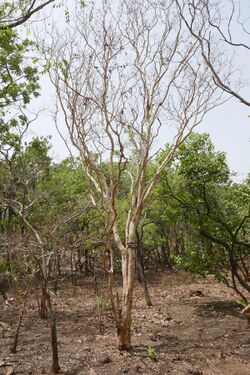Biology:Hymenocardia acida
| Hymenocardia acida | |
|---|---|

| |
| Scientific classification | |
| Kingdom: | Plantae |
| Clade: | Tracheophytes |
| Clade: | Angiosperms |
| Clade: | Eudicots |
| Clade: | Rosids |
| Order: | Malpighiales |
| Family: | Phyllanthaceae |
| Genus: | Hymenocardia |
| Species: | H. acida
|
| Binomial name | |
| Hymenocardia acida Tul.
| |
Hymenocardia acida is a plant of the family Phyllanthaceae native to tropical Africa. It is a small tree that grows to 10 m tall.[1][2] Occurs in the Guinea and Sudanian savannah zones and deciduous woodland, from Senegal eastwards to Ethiopia and southwards reaching Zimbabwe.[3][4]
Description
A dioecious and deciduous species,[3] the trunk is often short up to 30 cm in diameter, while the bark is commonly smooth, pale brown to grey in color, flakes off to reveal a powdery reddish to orange inner bark. The leaves are alternate, simple in arrangement with stipules that are up to 3 mm long; leaf-blade is elliptic to oblong in outline up to 9.5 cm long and 5 cm wide, and a coriaceous surface with golden to orange scales beneath.[3] Male flowers are reddish to yellow in color, and appears in axillary clusters of spikes up to 9 cm long. Female flower are green and in a terminal raceme. [3]
Chemistry
The Cyclopeptide alkaloid, hymenocardine has been isolated from the stem bark extract of the tree.[5] Leaf extracts identified the presence of the chemical compound lupeol.[5]
Uses
In traditional medical practice, some communities use leaf and root extracts as part of a regimen to treat malaria, inflammatory related ailments and pain, and various extracts of the plant is used to aid the healing process from skin ailments.[5]
References
- ↑ "African flowering plants database: Hymenocardia acida Tul.". Conservatoire et Jardin botaniques de la Ville de Genève. http://www.ville-ge.ch/musinfo/bd/cjb/africa/details.php?langue=an&id=174148. Retrieved 26 July 2021.
- ↑ "Hymenocardia acida - Species Information". The International Centre for Research in Agroforestry (ICRAF). http://www.worldagroforestry.org/treedb2/speciesprofile.php?Spid=17965. Retrieved 26 July 2021.
- ↑ 3.0 3.1 3.2 3.3 Medicinal plants. G. H. Schmelzer, Ameenah Gurib-Fakim, PROTA Foundation, Technical Centre for Agricultural and Rural Cooperation. Wageningen: PROTA Foundation. 2008. pp. 341. ISBN 978-90-5782-204-9. OCLC 297222192. https://www.worldcat.org/oclc/297222192.
- ↑ "Hymenocardia acida Tul. | Plants of the World Online | Kew Science" (in en). http://powo.science.kew.org/taxon/urn:lsid:ipni.org:names:350085-1.
- ↑ 5.0 5.1 5.2 Tuenter, Emmy; Exarchou, Vassiliki; Baldé, Aliou; Cos, Paul; Maes, Louis; Apers, Sandra; Pieters, Luc (2016-07-22). "Cyclopeptide Alkaloids from Hymenocardia acida" (in en). Journal of Natural Products 79 (7): 1746–1751. doi:10.1021/acs.jnatprod.6b00131. ISSN 0163-3864. PMID 27351950. https://pubs.acs.org/doi/10.1021/acs.jnatprod.6b00131.
External links
Wikidata ☰ Q5956467 entry
 |

